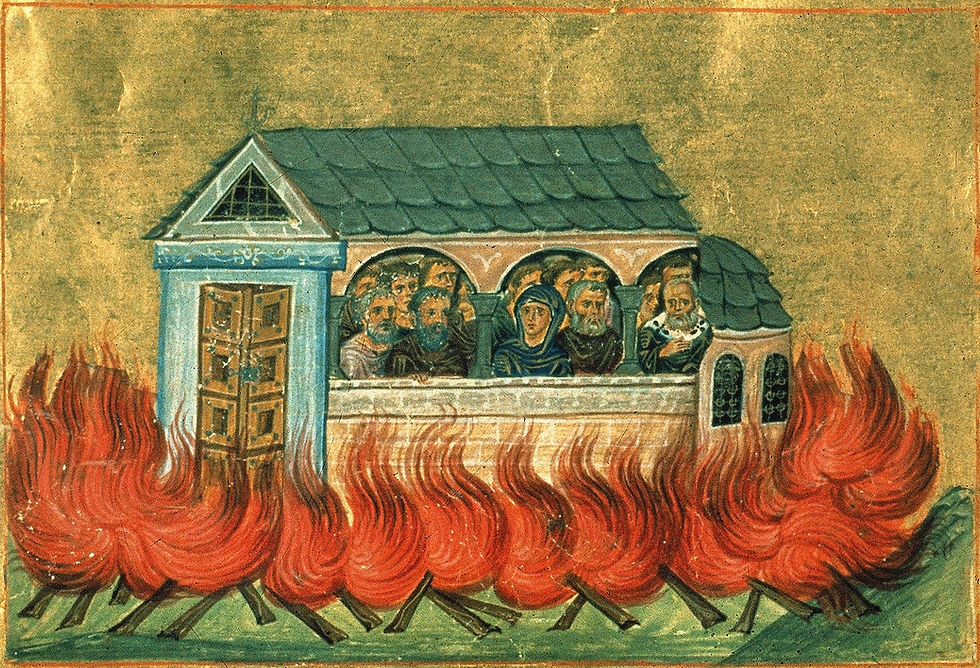The Installation of a Blue Plaque for E.R.Hughes
- Tim Boatswain

- Jul 23, 2023
- 2 min read
Updated: Jul 24, 2023

The installation of a blue plaque, at 3 Romeland, St Albans, to the artist Edward Robert Hughes on a very wet Saturday, Many thanks to Andy Lawrence for his excellent video:
On Saturday 22nd July luck ran out for Blue Plaques St Albans (BPSA). After installing eight blue plaques over the last couple of years in dry weather, the heavens opened with a deluge for the installation of a blue plaque, commemorating where the artist, Edward Robert Hughes, 'the last Pre-Raphaelite', lived at 3 Romeland, St Albans.
Despite appalling conditions, some hardy members of the public gathered outside the house to be addressed by Professor Geraint John, who has promoted Hughes over the years and had organised an exhibition of Hughes's work back in 2014, the centenary of the artist's death. After a short and wet ceremony, there was a retreat to inside No. 3 where Mr & Mrs. Roberts, the owners, had laid on a very welcome tea.
Professor Tim Boatswain, the Chair of BPSA commented:
It was a shame we didn't have better weather for this installation but full-marks to those enthusiasts who braved the rain. Blue Plaques St Albans is massively grateful to Robert and Joanna Morris for their sponsorship of the plaque for E.R.Hughes. It was a special occasion and wonderful that two of Hughes' great-grandnieces, Shelagh Nichols and Margaret Wilkinson, were able to attend. I hope this blue plaque will help foster public acclaim for this very accomplished artist.
Born in London, Edward Robert Hughes received his first training from his uncle, the eminent Pre-Raphaelite painter, Arthur Hughes. He spent much of his childhood surrounded by his uncle’s artistic and literary friends, including Dante Gabriel Rossetti, Ford Madox Brown, John Ruskin and Lewis Carroll.
Hughes took lessons at an art school in London, before entering the Royal Academy schools at the age of sixteen where he was an outstanding student, winning a silver medal.
His striking good looks led to his modelling for Rossetti and other artists. After graduating from the Royal Academy, he established a career as a portrait painter and his sensitive portraits of children were particularly popular. He later produced large, ambitious watercolours, inspired by poetry and literature, exhibiting twice a year at the Royal Watercolour Society.
From the late 1880s Hughes worked as a studio assistant to William Holman Hunt. Hunt was suffering from glaucoma in the last years of his life, progressively losing his sight, and Hughes helped him to complete the painting “The Lady of Shalott”. He is also credited with largely painting the third and final version of the “Light of the World”, a hugely popular painting now in St Paul’s Cathedral.
From 1905, Hughes made a series of large watercolours, exploring the themes of twilight, night and dawn, with fairy-like figures. It is perhaps these masterpieces on which the fame and reputation of E. R. Hughes is based.
In 1913 he moved with his wife, Emily, to St Albans. He loved the city but, sadly, he was stricken with appendicitis and died after surgery on St George's Day, 23 April 1914. His funeral at the Cathedral drew a huge attendance, reflecting how much his art had been admired. He is buried in the Hatfield Road Cemetery.




Comments